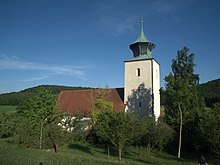St. Wolfgang (Velburg)
The Roman Catholic pilgrimage church of St. Wolfgang is a Gothic hall church in the district of St. Wolfgang von Velburg in the Upper Palatinate district of Neumarkt in the Upper Palatinate . As a branch church, it belongs to the parish of St. Johannes in Velburg in the Eichstätt diocese and is known for its artistically valuable Gothic winged altars .
History and architecture
The once heavily visited pilgrimage church is located on the south side of a rock on which a castle, first mentioned in 1280, stood. According to an inscription on the west side, the building was erected in 1467 by a foreman or bricklayer Peter Winden from Weiden in the Upper Palatinate ; older components have been preserved in the sacristy . The building was rebuilt in 1694 by Hans Puchtler from Velburg. In 1767 a flat ceiling was built into the nave and painted on the ceiling. A restoration took place in 1961. At present, the church is mainly used for the exit on Easter Monday, the procession before Ascension and the celebration of the church patronage on the last Sunday in October.
The building is a hall church, which is structured with buttresses and a coffin cornice that runs along the choir and the south side . It has a certain typological similarity to the Church of St. Leo in Bibra in Thuringia . Largely original two- and three-lane windows with tracery illuminate the interior. The west tower is finished with an unconventional curly dome . On the south side there is a portal in an ogival frame with bars stuck through. A slightly drawn-in choir with two yokes ends in a polygon made up of three sides of a hexagon. The choir is closed by a ribbed vault with grooved ribs, which show the original version, which was restored in 1961 according to findings. Plate-shaped keystones are provided with a renewed heraldic setting. The choir opens in a pointed arch to the nave, into which a western gallery is built on profiled arched arcades. On its parapet, the life of St. Wolfgang is depicted in four grisaille paintings from 1752. Ornamental and two figural ceiling paintings were made by Johann Georg Hämmerl from Velburg (according to a chronogram in 1757).
Furnishing
Three valuable late Gothic winged altars from the late 15th century, which have been restored several times, on the original canteens form the main works of the church's furnishings. The high altar, which was built around 1460/1470, shows figures of the saints Wolfgang, Willibald and Sebastian in front of a painted brocade curtain worn by angels. In the predella there is a painting with Christ and the twelve apostles. The detailed paintings of the wings, which show the four church fathers with the evangelist symbols in their medieval writing rooms, are particularly finely executed .
The two side altars, similar in style and structure, were donated by the Eichstätter canon Heinrich von Redwitz († 1500) and created by a different artist than the main altar. The center of the left altar is a crescent Madonna , flanked by reliefs of Saints John Baptist and John Evangelista . On the back there is a painting of the Annunciation, in the predella the finding of the cross by Saint Helena . The right altar shows Saint Catherine in the middle with reliefs of Saints Christopher and George in the wings and the painted representation of Our Lady among saints in the predella. On the back of the wings are paintings of Saints Barbara and Margaretha.
The communion grid was created at the beginning of the 17th century. On the choir walls there are four wing paintings from the side altars with depictions of Saints Apollonia , Ottilia , Anna selbdritt and Margaretha. On the left wall of the nave there are figures of St. Wolfgang from around 1480 and the Mother of Sorrows from the 18th century and a crucifix from the 16th century. Life-size figures of Saints Sebastian and Catherine from the second half of the 17th century can be found in the tower vestibule .
On the south wall of the nave is the wooden epitaph of the electoral Bavarian provisions officer David Stich († 1644) with depictions of the deceased, a Pietà and St. Wolfgang as well as a crucifix. The late Gothic door to the sacristy still has original fittings and a door handle on a plate in openwork forged work , which shows St. Wolfgang surrounded by dense branches.
literature
- Georg Dehio: Handbook of the German art monuments. Bavaria V: Regensburg and the Upper Palatinate. Deutscher Kunstverlag, Munich, Berlin 2008, ISBN 978-3-422-03118-0 , pp. 710–711.
Web links
Individual evidence
- ↑ Information on the St. Wolfgang pilgrimage church at velburg.de. Retrieved May 6, 2019 .
Coordinates: 49 ° 14 ′ 14.5 " N , 11 ° 41 ′ 14.6" E




